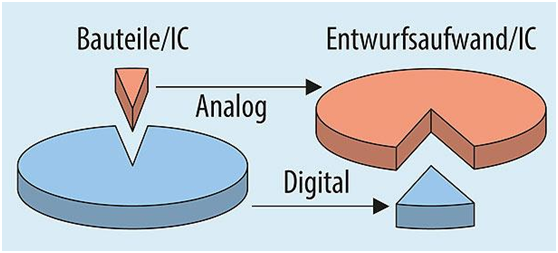Optimize the automation of analog integrated circuit design
Unlike digital ICs that can be designed to be highly automated, analog IC designs are still handmade today. Automated methods based on conventional optimization fail. In a research project, a new approach to analog IC design automation has been introduced.
Most advanced integrated circuits (ICs) are mixed-signal ICs consisting of analog and digital circuit components. Unlike digital circuit components that can be highly automated, the design of analog integrated circuits is still a complex and error-prone manual operation because the usual optimizations based on such automated methods fail periodically. Despite the increasing speed of digital IC components, analog designs are increasingly occupying design costs, and thus become the bottleneck for the shrinking of modern microelectronics technology.
This phenomenon is currently being studied at the University of Reutlingen to obtain a new approach to the automation of analog integrated circuit design.
Since the first ICs appeared in the early 1960s, microelectronics technology has been developing rapidly. It has greatly changed our lives in many areas and will continue to do so, digital, industry 4.0, the Internet of Things, seems to be getting stronger and coming in in less time.
Advances in semiconductor technology have made it possible to develop technology that allows more and more functions to be integrated on a single chip through continuous miniaturization.
Design automation
Despite the strong interest in high technology, two things are often overlooked. First of all, ICs need not only manufacturing but also development. Therefore, in the field of Electronic Design Automation (EDA), great efforts are being made to provide IC developers with increasingly powerful development tools to grasp their complexity. Today, the design of digital circuits is highly automated.
The design productivity (calculated on a per capita annual component) in digital integrated circuits (in the right scale) can also grow exponentially, but only half the growth rate of Moore's Law. This leads to the so-called "design cut". Therefore, the development of digital ICs has increased tenfold every 15 years.
Simulated draft shear
The second thing that is rarely noticed in the discussion of digitization is that electronic systems also require analog circuits. They create interfaces to the outside world - especially for implementing sensor signals, for controlling power electronics - and controlling internal power. The combination of these analog components with the digital logic on the chip has long been the norm.
Most of today's ICs fall into this category, the so-called mixed-signal ICs. If a power transistor is added, it is called a smart power IC.

© Reutlingen University
Figure 1. Productivity gaps in analog integrated circuit design - Bottlenecks in microelectronics.
When considering design efficiency, the real problem becomes clear. The design of digital circuit components is highly automated. In contrast, analog circuit components are primarily designed manually today.
This has led to a considerable 90% of the design work in Figure 1. The flow problems shown in an analog circuit of a mixed-signal or smart power IC - although these analog sections typically only contain a few percent of the components of the IC. This means that the productivity of analog designs is two to three orders of magnitude lower than digital designs.
Therefore, analog design is a major cost factor for mixed-signal IC design. This represents the core issue of microelectronics, which is especially important for the German semiconductor industry.
The dominant position of analog design as a cost driver is so strong that the problem is getting worse as the range of analog functions gets larger, even though digital circuit components grow stronger than analog circuits. The main reason is that the productivity gains of analog designs cannot keep up with the growth of integrated analog functions. We call this phenomenon more and more eye-catching since the millennium, that is, "simulated cut."
The purpose of the University of Reutlingen is to study and provide a novel design method for analog IC design that successfully performs simulated shearing.

